| Columns Retired Columns & Blogs |
California Audio Labs CL-15 CD player Measurements
Sidebar 4: Measurements
The CL-15 was measured with its options set to the default settings, the condition in which it was auditioned by Brian Damkroger. One exception was the maximum level, which was at the higher option. From the single-ended outputs, the maximum level at 1kHz was 3.08V RMS, 3.75dB higher than the CD standard. As expected, the maximum voltage from the balanced outputs was exactly twice that, at 6.16V. The output impedance was a low 37 ohms from the single-ended jacks, 114 ohms from the balanced. The output polarity was absolute phase-correct from the single-ended outputs and from the balanced outputs with the XLR jack's pin 2 wired as "hot." Despite of BD's comment on "phasiness" from the balanced outputs, both left and right jacks were wired identically.
The volume control worked as expected, with no real reduction in resolution when used at the top of its range, but I was disappointed that there was no visual indication of volume on the CL-15's front-panel display. When it came to error correction, the CL-15 was a champion. Using the Pierre Verany test CD, I found that the player could cope with gaps in the data up to 1.5mm in length, way better than the requirements of the CD standard.
Given BD's comments on the CL-15 having a slightly lean balance, I found it interesting that its frequency response did show a slight lift in the top two audio octaves. Fig.1 shows the response at 0dBFS from the single-ended outputs; the response from the balanced outputs featured slightly less top-octave boost. The maximum error is +0.25dB at 15.6kHz, which might not be much but as the error does cover almost two octaves, its audibility might well be higher than anticipated. Similarly, the very slight boost in the low bass might also just be audible. The response with deemphasis was identical. Crosstalk (not shown) was superb, the worst-case channel separation at 20kHz still lying below –90dB in both directions. Below 1kHz, the crosstalk was below the player's noise floor.
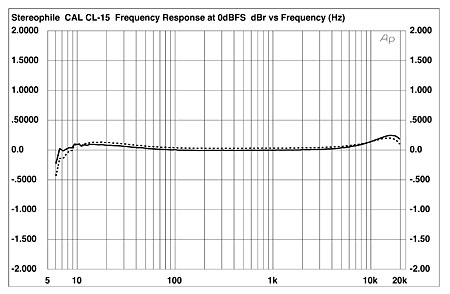
Fig.1 California Audio Labs CL-15, single-ended, frequency response at 0dBFS (right channel dashed, 0.5dB/vertical div.).
Fig.2 shows the CL-15's balanced output spectrum while it played back data representing a dithered 1kHz tone at –90dBFS. The trace is free form harmonic components, but power supply noise can be seen at the full-wave switching frequency and its harmonics. This was consistent no matter how I changed the grounding arrangements and was slightly worse from the balanced outputs. In absolute terms, however, it is still inconsequentially low. These spuriae can also be seen in fig.3, which shows the spectrum of the player's output plotted up to 200kHz. Not the broad ultrasonic energy peak in this graph, centered on twice the sample rate.
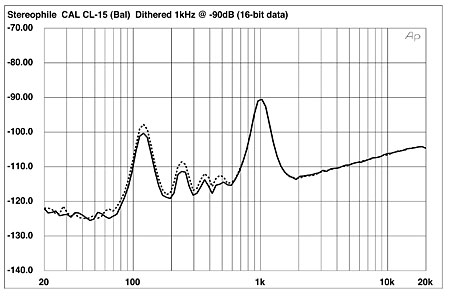
Fig.2 California Audio Labs CL-15, balanced, spectrum of dithered 1kHz tone at –90.31dBFS, with noise and spuriae (16-bit data, right channel dashed).
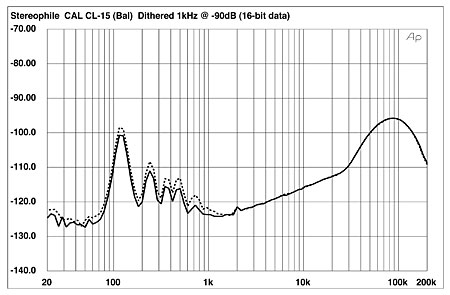
Fig.3 California Audio Labs CL-15, balanced, spectrum of digital silence with noise and spuriae. (16-bit data, 1/3-octave analysis, right channel dashed)
As is usual with players using the Burr-Brown PCM1702 DAC, the CL-15's linearity (fig.4) was excellent, there being no significant amplitude error evident to well below –100dBFS. Both this fine linearity and the CL-15's very low noise floor contribute to the excellent reproduction of an undithered 1kHz tone at –90.31dBFS (fig.5). The signal at this level is defined by just two symmetrical voltage levels either side of the time axis; both can be seen in this graph, as can the Gibbs Phenomenon "ringing" at each level transition.
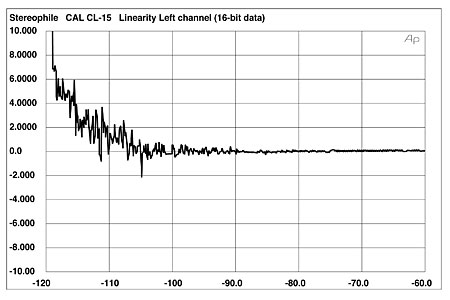
Fig.4 California Audio Labs CL-15, left-channel departure from linearity (2dB/vertical div.).
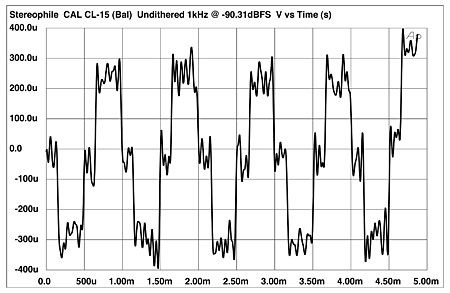
Fig.5 California Audio Labs CL-15, balanced, waveform of undithered 1kHz sinewave at –90.31dBFS (16-bit data).
The CL-15 also offered very low levels of distortion. Fig.6 shows the spectrum of the player's output while it reproduced a high-level, low-frequency 61Hz tone. The only harmonics visible above the noise-floor "grass" are the third, fourth, seventh, and thirteenth and these are all at very low levels, the highest (third) lying at –93dB (0.002%). The CL-15 was a little less linear on high levels of high-frequency tones: fig.7 shoes the spectrum of the player's output while it coped with 19kHz and 20Kz tones, each at $6dBFS (the combined waveform just reaches 0dBFS). The 1kHz difference tone lies at –76dB (0.015%), which is higher than I would have expected, but still very low in absolute terms.
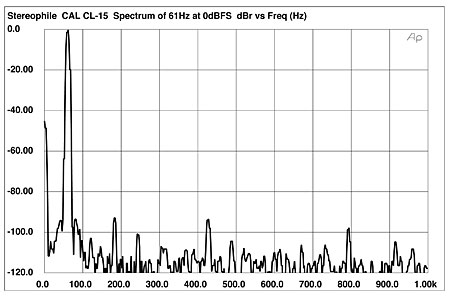
Fig.6 California Audio Labs CL-15, balanced, spectrum, DC–1kHz, 61Hz at 0dBFS (linear frequency scale, 20dB/vertical div.).
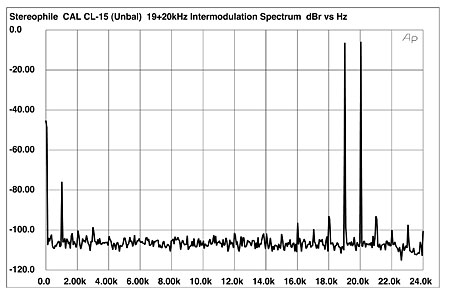
Fig.7 California Audio Labs CL-15, single-ended, HF intermodulation spectrum, DC–22kHz, 19+20kHz at 0dBFS (linear frequency scale, 20dB/vertical div.).
As well as very low noise and distortion, the California Audio Labs player has extremely low word-clock jitter. The black trace in fig.8 shows a narrow-band FFT analysis of its output, made with the Miller Audio Research Jitter Analyser, while the CL-15 reproduced a combination of an 1kHz tone at –6dBFS and a 229Hz tone at the 1LSB level. The measured peak jitter level was a low 213.5ps, almost all which is data-related. (The spectral sidebands indicated with red numbered markers are spaced at 229Hz intervals.)
For reference, the grayed-out trace in fig.8 is the spectrum of the Meridian 508-24's output, taken under identical conditions. The Meridian has far less data-related jitter, explaining its extraordinarily low peak jitter level of 144.2ps, but note the slight spreading of its central spectral line compared with the CL-15's, as well as the presence of some low-frequency spuriae. And you can also see that the California Audio Labs player's noise floor is as low as the Meridian's, both approaching the limit of the CD's 16-bit encoding system. The absolute clock error was a low 40ppm.
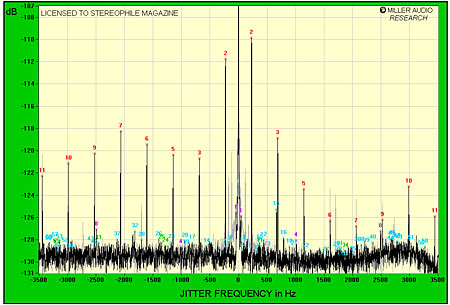
Fig.8 California Audio Labs CL-15, high-resolution jitter spectrum of analog output signal (11kHz at –6dBFS with LSB toggled at 229Hz). Center frequency of trace, 11kHz; frequency range, ±3.5kHz. (Grayed-out trace is the Meridian 508-24.)
BD commented that there were no substantive differences in sound quality between the CL-15 playing a CD and it decoding an auxiliary digital datastream. As can be seen from fig.9, the CL-15 features even lower jitter when fed an S/PDIF datastream. The grayed-out trace in this graph is the CL-15's narrow-band spectrum from fig.8; the black trace is its jitter spectrum when fed data from a PS Audio Lambda CD transport via 6' of Illuminati S/PDIF cable. The measured jitter level has dropped to just 125.7ps, due to the radical reduction in the level of the data-related sidebands. Those at ±229Hz, for example, have dropped from 168.3ps to 48.3ps! The CL-15 obviously must have a fine data receiver circuit, as well as being well matched to the impedance of the Illuminati datalink.
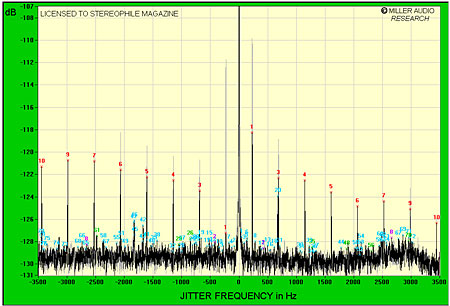
Fig.9 California Audio Labs CL-15, auxiliary data input, high-resolution jitter spectrum of analog output signal (11kHz at –10dBFS with LSB toggled at 229Hz). Center frequency of trace, 11kHz; frequency range, ±3.5kHz. (Grayed-out trace is the CL-15 reproducing a CD signal.)
I did find that using the volume control to provide some attenuation did affect these jitter measurements. Setting it to –6dB increased the jitter to 270ps, with now some low-frequency sidebands evident. If you want to use the CL-15 straight into a power amplifier, set the player's maximum output level with the Windows software to allow the volume control to be used near the top of its range at your preferred listening levels. other than that caveat, these measurements reveal the California Audio Labs CL-15 to be a superb-performing CD player.—John Atkinson
- Log in or register to post comments



































